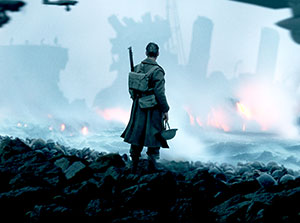
The sweeping World War II saga “Dunkirk” is currently playing at the Somerville Theatre.
By Dre Joseph
With a few lines of prologue and a lack of any traditional exposition, Dunkirk immediately hurls the audience into the tense atmosphere that encapsulated the aforementioned beach during one of the Allied Forces’ lowest moments in World War II. What follows are 106 minutes of heart-pounding, riveting, and majestically-crafted cinema from direction so assured that the three disjointed narratives beautifully merge into a singular masterpiece.
Set after the events that led to this “colossal military disaster,” the film opens as Tommy, portrayed by newcomer Fionn Whitehead, and several other British soldiers scavenge the town for food and water. They are wordless, but their gloomy mannerisms embody their defeated spirits. Whether it be the endless onslaught of fliers promising them no escape from the German encirclement or the beach littered with an increasing number of bodies, hope is a scarcity amongst the soldiers. Tommy is no different.
After nimbly escaping enemy fire, he encounters the equally quiet Gibson (Aneurin Barnard) and together they attempt to sneak onto a medical ship disguised as stretcher-bearers. After their plan is foiled, they are joined by another young lad. You would be forgiven for not immediately recognizing him as the front man of Britain’s most famous boy band. With surprising authenticity, Harry Styles seamlessly blends into the story and conveys impressive emotional depth despite his limited dialogue.
 From there, Dunkirk divides its time between three different narratives operating asynchronously. While the film presents the timeframes of each (a week on land in “the mole,” one day for “the sea,” and one hour for “the air”), their relationship to each other is made intentionally unclear. Although Nolan is certainly the chess-master of this narratively-complex board, much credit is due to his longtime editor, Lee Smith, who eloquently blends these three narratives. Their moment of unison is one of the film’s most rewarding scenes.
From there, Dunkirk divides its time between three different narratives operating asynchronously. While the film presents the timeframes of each (a week on land in “the mole,” one day for “the sea,” and one hour for “the air”), their relationship to each other is made intentionally unclear. Although Nolan is certainly the chess-master of this narratively-complex board, much credit is due to his longtime editor, Lee Smith, who eloquently blends these three narratives. Their moment of unison is one of the film’s most rewarding scenes.
“The sea” showcases the heroic efforts of an elder Englishman (humbly portrayed by Mark Rylance) and two teenagers as they cross the English Channel to assist in the Dunkirk evacuation. Although they are more removed from the immediacy of danger that surrounds the other stories, there is increased nervousness with each additional scene as hopeful heroism clashes with the bitter realities of war.
Finally, through some truly acrobatic camerawork (courtesy of Hoyte van Hoytema), “the air” tracks Farrier (Tom Hardy) and company as they engage in multiple dogfights in a flurried effort to protect Allied Forces attempting to evacuate. Outside of a few introductory lines, these sequences are conducted in near-silence with only the steely sounds of machine gun fire and Hans Zimmer’s bombastic score to occupy our ears.
As neither a particularly long (106 minutes) nor violent (a rare PG-13 Rating) film, Dunkirk is quite the anomaly within the war genre. Films like American Sniper or Hacksaw Ridge relish in every opportunity to display frenzied carnage. Yet, writer-director Christopher Nolan does little more than showcase a few bloodied soldiers being carted away in stretchers. That is not to say that death and imminent doom are also excluded. Whether it be bullets, torpedoes, bombs, or any of another dozen undesirable ways to die, the audience is given little reprieve from the dangers that surround every scene and character.
While the characters are little more than a name and a face (as basic as the Shivering Man in Cillian Murphy’s case), there is a poetic simplicity in their design. In the long history of war films, small and insignificant characters are easy targets for a brutal death and the audience will rarely bat an eye. Yet in Dunkirk, this anonymity extends to all characters as we observe their quests in near silence. This is not to suggest that the characters are poorly composed or acted. Quite the opposite is true. The ensemble of actors carry the film with such reverence to the realities of Dunkirk that they do not overstep their bounds. Instead, they fall in step, akin to the 400,000 soldiers, villagers, and Englishmen as they highlight the broader moment.
There are no singular heroes here, only men and women persevering through this trying peril while doing what little they can to maintain their humanity. Dunkirk so wisely avoids populist sentimentality and when the credits ultimately roll, there is no singular emotion the audience feels. Joy, sorrow, relief, and frustration all keenly meshed together.
In a genre filled with some of cinema’s finest treasures, that is no easy task. Christopher Nolan accomplishes this with expert marksmanship without resorting to old tricks. This highlights his growth as a filmmaker. Few directors would have attempted a project so ambitious, but that is his trademark. Nolan consistently reimagines a genre without sacrificing its profitability. Dunkirk is certainly no different.
Verdict:
Through nuanced performances and sweeping cinematography, Dunkirk reasserts Christopher Nolan’s talent as a filmmaker of the finest order. One could even say this is, in some ways, is a love letter to future filmmakers. But, for all of you film nerds out there, Dunkirk is a must-see and is currently playing at the Somerville Theatre in Davis Square (go online for show times: http://somervilletheatre.com/).
And sure, you can say it, tell them Dre sent you!
Rating: 4/4















Reader Comments